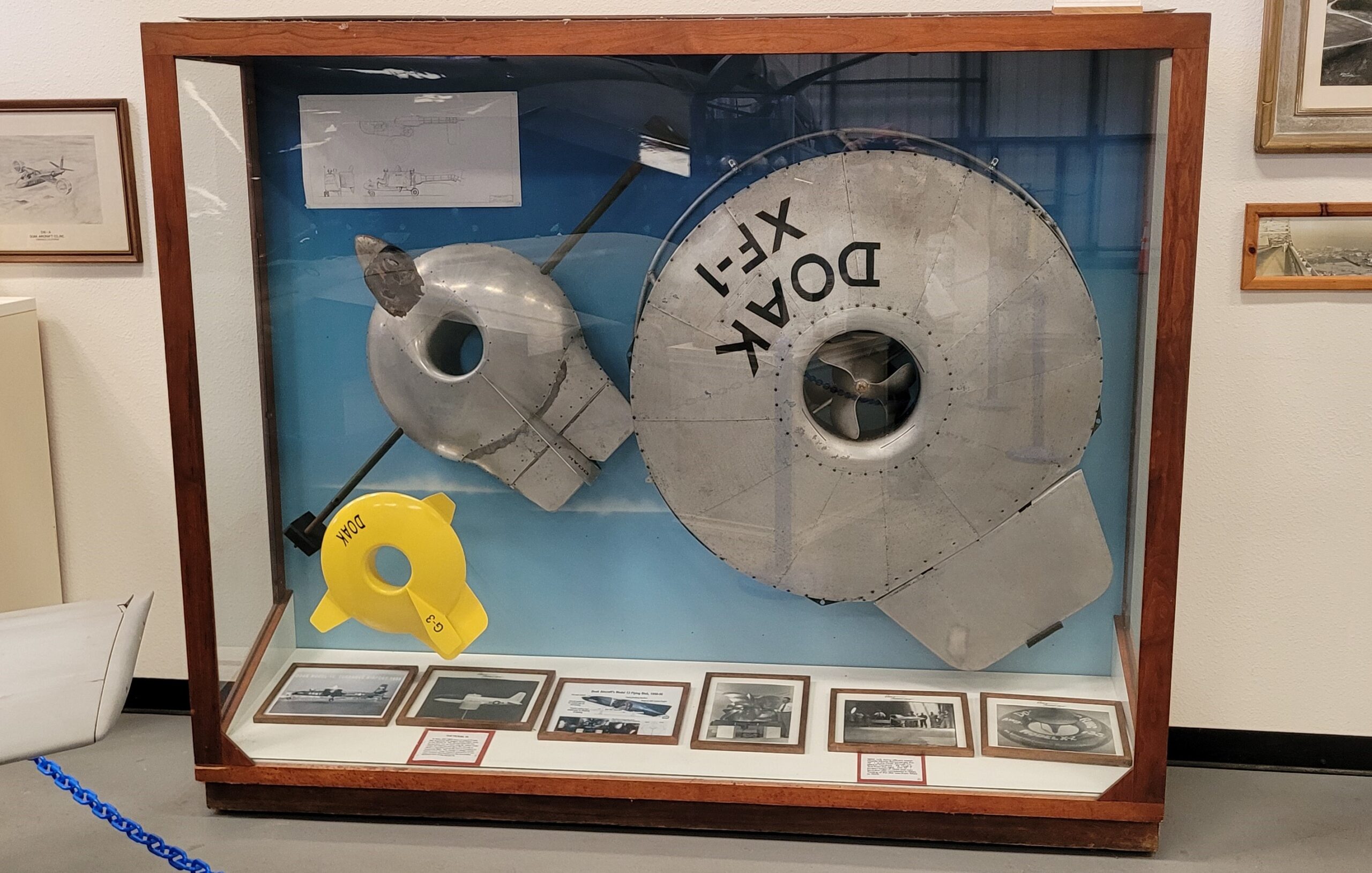Doak Aircraft Company
Edmond R. Doak, Jr., a self-taught engineer and visionary, contributed significantly to the aviation industry, although he was largely unknown. Doak joined the military during World War I as an aircraft inspector, worked for Glenn L. Martin, North American Aviation and Douglas Aircraft Company.
In 1939, Edmond Doak founded the Doak Aircraft Company in Torrance, California. The company grew to nearly 4,000 employees during World War II with subcontracts from every major American aircraft manufacturer. These included molded wood fuselages for trainers such as the North American AT-6 and Vultee BT-13, control surfaces, bomb bay doors, hatches, gun turrets, bomb racks other assemblies and parts for a multitude of aircraft.
Edmond Doak had been experimenting with GEM (Ground Effect Machines) air-moving Impeller concepts with his Model X-2 in 1935 and subsequently ducted fans for vertical takeoff and landing. The Doak Aircraft Company, known for its Model 16 ducted fan (also known as the Doak VZ-4DA, Army designation), designed and built experimental aircraft, specifically focusing on vertical takeoff and landing (VTOL)
The three Doak GEM models in the display case were experimental, vertical takeoff and landing (VTOL) concept aircraft with futuristic disk-shaped features. Looking at the display case from left to right is the Doak G-3, Doak 11 and the Doak XF-1
The X-F1 project began in 1949 and construction was completed in 1950. Testing of the XF-1 GEM was from 1950 to 1953 and was accomplished with a tether, typically a cable or wire, connecting the aircraft to a ground station. This tether can provide power to the aircraft. Tethered testing reduces the risk associated with full, free flight, especially during early development phases. The aircraft can be moved or hovered in a controlled manner allowing for testing of various parameters of thrust, handling, and performance characteristics. The tether can be used to vary the effective weight of the aircraft by varying the tension applied to the cable. The tether allows for precise control of the aircraft’s position and movement, facilitating data collection and experimentation of aircraft performance in ground effect and out-of-ground effect hover.
From 1950 to 1956, Doak Aircraft developed and tested a Model 13 with tricycle landing gear, a two-seat cockpit, with large contra-rotating impellers and was powered via a gear box by a Wright 1820 Cyclone engine.
After years of research with various experimental aircraft designs, Doak started developing the Model 15 in 1954. It had two ducted fans, one on each wing tip. Doak proposed such a VTOL aircraft to the U.S. Army, and on April 10, 1956, it awarded Doak aircraft company a contract to produce a single prototype for use as a research VTOL aircraft.
Doak began work on the prototype and was designated as the Doak Model 16. This aircraft featured two ducted fans, one on each wing tip, which could rotate 90 degrees and allow the aircraft to climb or descend vertically and transition to horizontal flight. Vanes in the tail used engine exhaust to provide pitch and yaw control during hovering flight. The aircraft was flown with direct mechanical controls and did not have electronic stabilization.
The aircraft was powered by a YT-53 Lycoming turboshaft engine producing 825 Shaft Horsepower (SHP). Flight testing began at Torrance Municipal Airport and Doak completed several tests by 1958. The Model 16 hovered for the first time on 25 February 1958 and the first transition from vertical to horizontal flight took place on 5 May 1958. Although the prototype was generally successful, its vertical takeoff and landing performance was limited due to engine performance and weight. It was noted that the prototype had exhibited a slight pitching moment while making the transition from vertical to horizontal flight and back at 50 knots.
Doak’s engineers believed that they could solve the prototype’s problems. After taxi testing, 32 hours of flight testing in a test stand, and 18 hours of tethered hovering, the aircraft was transferred to Edwards Air Force Base, California, in October 1958. It underwent another 50 hours of testing in which it proved capable as the pitching moment was reduced by half and with the upgraded T-53 turboshaft engine with 1,000 (SHP) achieving a maximum speed of 230 mph and a cruise speed of 175 mph.
The U.S. Army accepted the prototype in September 1959, designated it the Doak VZ-4DA, and passed it to the NASA Langley Research Center in Hampton, Virginia, for further testing. When Doak laid off 90 percent of his employees in late 1960 due to a recession in the aircraft industry, Douglas Aircraft took over the project and purchased its patent rights and engineering files and hired three engineers from Doak to continue work on the VZ-4DA.
Work continued on the Doak VZ-4DA until 1963, when the U.S. Army decided that a helicopter would meet its VTOL requirements and shifted funding away from the design and testing of unconventional VTOL aircraft to the design and procurement of helicopters and discontinued trials of the VZ-4DA. The National Aeronautics and Space Administration (NASA), later acquired the aircraft and continued testing flights through 1972.
Only a single prototype Model 16 (VZ-4DA) serial number 56-9642 was built. In January 1973, the VZ-4DA was donated to the U.S. Army Transportation Museum at Fort Eustis, Virginia, where it was placed on public display with other aircraft in the museum’s outdoor Aviation Pavilion. In August 2024, the VZ-4DA was permanently transferred to the U.S. Army Aviation Museum.









